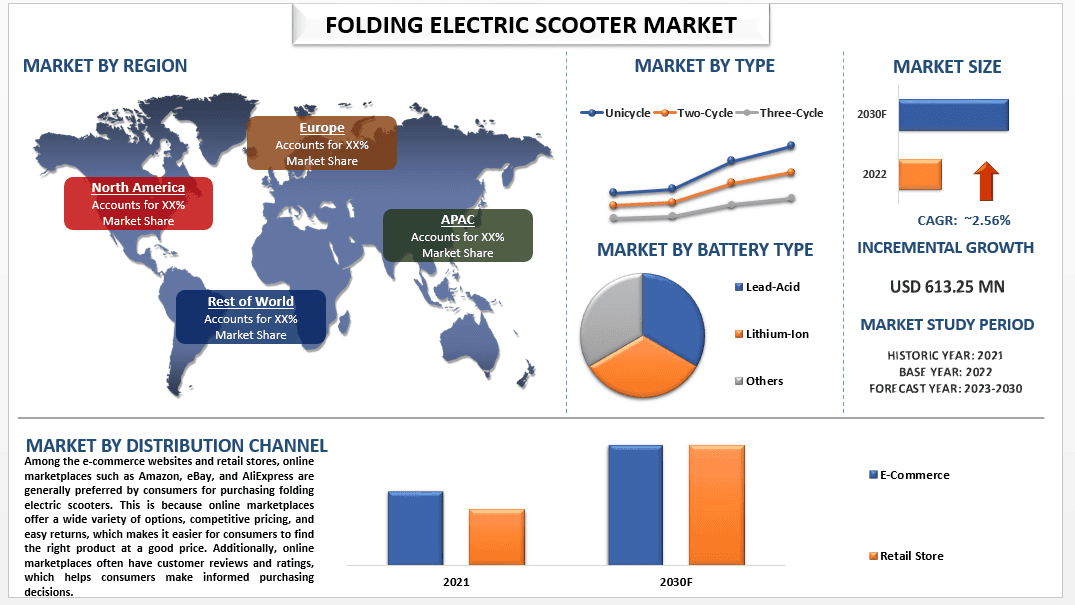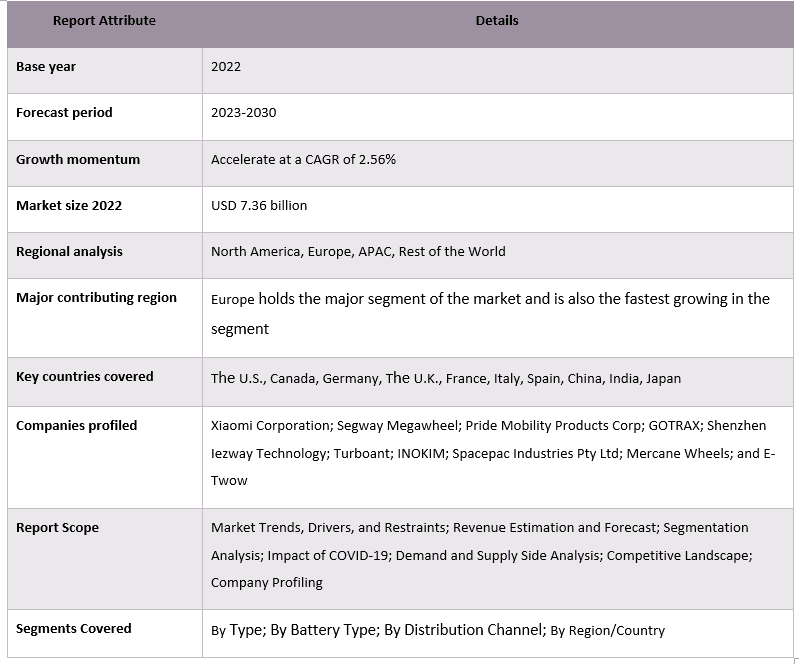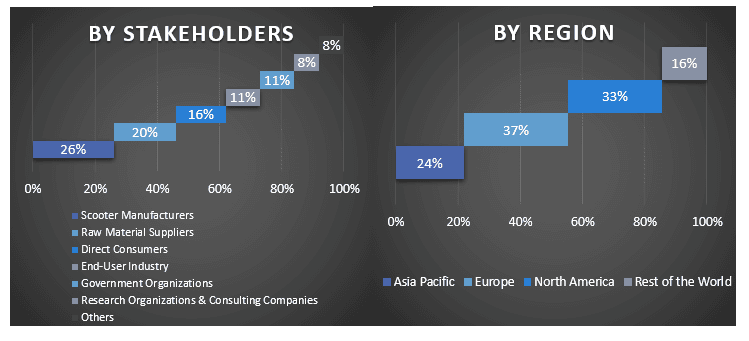- Trang chủ
- Về chúng tôi
- Ngành
- Dịch vụ
- Đọc
- Liên hệ với chúng tôi
Thị trường Xe Scooter Điện Gấp Gọn: Phân tích Hiện tại và Dự báo (2023-2030)
Nhấn mạnh vào Loại (Xe một bánh, Xe hai bánh và Xe ba bánh), Loại Pin (Axit-chì, Lithium-Ion và Loại khác); Kênh Phân phối (Thương mại điện tử và Cửa hàng bán lẻ); và Khu vực/Quốc gia

Thị trường Xe Điện Gấp Gọn được định giá 613,25 triệu USD vào năm 2022 và dự kiến sẽ tăng trưởng với tốc độ ổn định khoảng 2,56% trong giai đoạn dự báo (2023-2030), do nhu cầu ngày càng tăng đối với các lựa chọn di chuyển siêu nhỏ bền vững ở khu vực thành thị. Hơn nữa, một trong những động lực chính thúc đẩy sự tăng trưởng của thị trường xe điện gấp gọn là việc ngày càng có nhiều mô hình MaaS (Di động như một Dịch vụ) được chấp nhận. Khi ngày càng có nhiều thành phố áp dụng nền tảng MaaS, nhu cầu về các lựa chọn vận chuyển thuận tiện, linh hoạt và bền vững có thể được truy cập thông qua các nền tảng này ngày càng tăng. Xe điện gấp gọn rất phù hợp để đáp ứng nhu cầu này vì chúng mang lại một số lợi thế so với các phương tiện cơ giới truyền thống. Chúng tương đối yên tĩnh, sạch sẽ và thân thiện với môi trường, khiến chúng trở thành một lựa chọn hấp dẫn cho kết nối chặng cuối và nhu cầu vận chuyển địa phương. Ngoài ra, chúng dễ dàng điều khiển và đỗ xe, khiến chúng rất phù hợp để di chuyển trên những con phố hẹp và không gian chật hẹp. Ngoài ra, khi các nền tảng MaaS tiếp tục phát triển về mức độ phổ biến, chúng ta có thể kỳ vọng sẽ thấy nhu cầu ngày càng tăng đối với xe điện gấp gọn và các lựa chọn vận chuyển bền vững khác có thể được tích hợp liền mạch vào các nền tảng này. Điều này có thể dẫn đến sự tăng trưởng và đổi mới hơn nữa trong thị trường xe điện gấp gọn, khi các công ty tìm cách phát triển các sản phẩm mới và cải tiến có thể đáp ứng nhu cầu thay đổi của người tiêu dùng. Ví dụ: vào tháng 4 năm 2023, Yadea Global, một nhà sản xuất xe hai bánh điện, đã ra mắt Yadea Elite Prime, một chiếc xe điện gấp gọn với cơ chế gấp dễ dàng. Xe điện tử mới được trang bị động cơ 800W mạnh mẽ với công suất cực đại 1500W và mô-men xoắn 40 Nm, cho phép đạt tốc độ tối đa lên tới 18,6 dặm/giờ (30 km/giờ). Nó có khả năng leo dốc lên đến 30 phần trăm và hệ thống treo trước và sau của nó sẽ mang lại một chuyến đi thoải mái ngay cả trên những con đường gồ ghề.
Một số nhà sản xuất lớn đang hoạt động trên thị trường là Xiaomi Corporation; Segway Megawheel; Pride Mobility Products Corp; GOTRAX; Shenzhen Iezway Technology; Turboant; INOKIM; Spacepac Industries Pty Ltd; Mercane Wheels; và E-Twow. Một số thương vụ M&A cùng với các quan hệ đối tác đã được thực hiện bởi những người chơi này để tạo điều kiện cho khách hàng với các sản phẩm/công nghệ công nghệ cao và sáng tạo.
Thông tin chi tiết được trình bày trong Báo cáo
"Trong số các Loại, phân khúc hai chu kỳ nắm giữ thị phần đáng kể trên thị trường vào năm 2022."
Dựa trên loại, thị trường được phân chia thành một bánh, hai chu kỳ và ba chu kỳ. Xe điện gấp gọn được sử dụng rộng rãi, phổ biến và có nhu cầu cao nhất là xe hai bánh. Điều này là do nó mang lại sự cân bằng giữa sự ổn định, tốc độ và khả năng cơ động, khiến nó phù hợp cho cả khoảng cách ngắn và dài. Ngoài ra, nó có một thiết kế đẹp mắt, làm cho nó trở nên hấp dẫn và đáng mong muốn về mặt thị giác. Xe tay ga gấp hai bánh ổn định hơn, có khả năng đạt tốc độ cao hơn và mang lại chuyến đi thoải mái hơn so với các loại khác. Tăng sự tự tin cho người lái và mang lại vị trí lái thoải mái hơn và giảm mệt mỏi.
"Trong số các loại pin, phân khúc pin lithium-ion được dự đoán sẽ tăng trưởng với tốc độ CAGR đáng kể trong giai đoạn dự báo (2023-2030)."
Dựa trên loại pin, thị trường được chia thành axit-chì, lithium-ion và các loại khác. Pin lithium-ion chiếm phần lớn thị trường pin được sử dụng trong xe điện gấp gọn. Các yếu tố nổi bật chịu trách nhiệm cho sự thống trị này là mật độ năng lượng cao của pin lithium-ion, khiến chúng trở thành một lựa chọn lý tưởng cho những loại pin này. Hơn nữa, việc sản xuất pin lithium-ion ngày càng tăng và những tiến bộ công nghệ trong lĩnh vực này đã dẫn đến việc giảm chi phí của các loại pin này, khiến chúng trở nên giá cả phải chăng và thiết thực để thương mại hóa. Hơn nữa, những đổi mới liên tục và R&D liên tục diễn ra trong phân khúc này đã làm cho pin an toàn hơn và tăng tuổi thọ hoạt động và độ tin cậy của chúng với phạm vi tăng lên, thúc đẩy hơn nữa các nhà sản xuất sử dụng pin lithium-ion cho xe điện gấp gọn. Việc bổ sung giá trị này cho cả người tiêu dùng cũng như nhà sản xuất dẫn đến nhu cầu ngày càng tăng đối với xe điện gấp gọn chạy bằng pin lithium-ion và điều tương tự có thể thấy từ việc ra mắt sản phẩm của những người chơi đang hoạt động trong phân khúc này. Ví dụ: Vào tháng 5 năm 2023, thương hiệu Zinc Sports của Anh đã ra mắt một chiếc xe tay ga điện gấp mới, có tên là Eco Pro. Folding Electric Pro được cung cấp năng lượng bởi pin lithium-ion, mất bốn giờ để sạc và được thiết kế để thu hút đối tượng trẻ tuổi hơn như một giải pháp "người đi làm thường xuyên" từ Zinc.
Báo Cáo Phạm Vi Thị Trường Xe Điện Gấp Gọn

"Châu Âu được dự đoán sẽ chứng kiến sự tăng trưởng đáng kể về CAGR, của thị trường phân khúc xe điện gấp gọn trong giai đoạn dự báo (2023-2030)."
Châu Âu đã nổi lên như một nhà lãnh đạo và cũng là một trong những thị trường phát triển nhanh nhất cho xe điện gấp gọn trên toàn cầu, được thúc đẩy bởi các yếu tố như các quy định nghiêm ngặt về môi trường, nơi chính phủ ở các quốc gia này đang khuyến khích các ngành công nghiệp chuyển sang các giải pháp thay thế chạy bằng điện. Châu Âu từ lâu đã đi đầu trong các công nghệ vận chuyển sáng tạo và sự hiện diện mạnh mẽ của nó trong lĩnh vực di chuyển siêu nhỏ có thể là do một số yếu tố. Thứ nhất, lục địa này đã chứng kiến sự gia tăng nhanh chóng về đô thị hóa, dẫn đến các thành phố tắc nghẽn và nhu cầu về các phương thức vận chuyển hiệu quả trong các khu vực này. Thứ hai, các chính phủ đã thực hiện các chính sách thúc đẩy tính bền vững và giảm lượng khí thải carbon, điều này đã khuyến khích đầu tư vào các giải pháp vận chuyển thân thiện với môi trường. Cuối cùng, sự gia tăng của các dịch vụ di chuyển chung như chương trình chia sẻ ô tô và chia sẻ xe đạp đã thúc đẩy hơn nữa sự tăng trưởng của ngành công nghiệp di chuyển siêu nhỏ, do đó tạo ra nhu cầu lớn đối với xe điện gấp gọn, nơi việc sử dụng nó cho nhu cầu di chuyển chặng cuối là ở khu vực Châu Âu. Ngoài ra, một số công ty hoạt động trong thị trường xe điện gấp gọn của Châu Âu đang tập trung vào việc phát triển các sản phẩm và dịch vụ sáng tạo được thiết kế để đáp ứng các nhu cầu cụ thể của khách hàng địa phương.
Lý do nên mua báo cáo này:
- Nghiên cứu bao gồm phân tích kích thước và dự báo thị trường được xác nhận bởi các chuyên gia ngành công nghiệp quan trọng đã được xác thực.
- Báo cáo trình bày đánh giá nhanh về hiệu suất tổng thể của ngành trong nháy mắt.
- Báo cáo bao gồm một phân tích chuyên sâu về các đồng nghiệp ngành nổi bật với trọng tâm chính là tài chính kinh doanh chính, danh mục sản phẩm, chiến lược mở rộng và những phát triển gần đây.
- Kiểm tra chi tiết các yếu tố thúc đẩy, hạn chế, xu hướng chính và cơ hội hiện hành trong ngành.
- Nghiên cứu bao gồm toàn diện thị trường trên các phân khúc khác nhau.
- Phân tích sâu cấp khu vực của ngành.
Tùy chọn Tùy Chỉnh:
Thị trường xe điện gấp gọn toàn cầu có thể được tùy chỉnh thêm theo yêu cầu hoặc bất kỳ phân khúc thị trường nào khác. Bên cạnh đó, UMI hiểu rằng bạn có thể có nhu cầu kinh doanh riêng, vì vậy hãy liên hệ với chúng tôi để nhận báo cáo hoàn toàn phù hợp với yêu cầu của bạn.
Mục lục
Phương Pháp Nghiên Cứu Phân Tích Thị Trường Xe Scooter Điện Gấp (2023-2030)
Phân tích thị trường trong quá khứ, ước tính thị trường hiện tại và dự báo thị trường tương lai của thị trường xe scooter điện gấp toàn cầu là ba bước chính được thực hiện để tạo và phân tích sự chấp nhận xe scooter điện gấp ở các khu vực lớn trên toàn cầu. Nghiên cứu thứ cấp toàn diện đã được tiến hành để thu thập số liệu thị trường trong quá khứ và ước tính quy mô thị trường hiện tại. Thứ hai, để xác thực những thông tin chi tiết này, nhiều phát hiện và giả định đã được xem xét. Hơn nữa, các cuộc phỏng vấn sơ cấp toàn diện cũng đã được thực hiện với các chuyên gia trong ngành trên toàn bộ chuỗi giá trị của thị trường xe scooter điện gấp toàn cầu. Sau khi giả định và xác thực số liệu thị trường thông qua các cuộc phỏng vấn sơ cấp, chúng tôi đã sử dụng phương pháp tiếp cận từ trên xuống/từ dưới lên để dự báo quy mô thị trường hoàn chỉnh. Sau đó, các phương pháp phân tích chi tiết thị trường và tam giác dữ liệu đã được áp dụng để ước tính và phân tích quy mô thị trường của các phân khúc và phân khúc con của ngành liên quan đến. Phương pháp chi tiết được giải thích dưới đây:
Phân Tích Quy Mô Thị Trường Trong Quá Khứ
Bước 1: Nghiên Cứu Chuyên Sâu Các Nguồn Thứ Cấp:
Một nghiên cứu thứ cấp chi tiết đã được tiến hành để thu thập quy mô thị trường trong quá khứ của thị trường xe scooter điện gấp thông qua các nguồn nội bộ của công ty như báo cáo thường niên & báo cáo tài chính, thuyết trình hiệu suất, thông cáo báo chí, v.v., và các nguồn bên ngoài bao gồm tạp chí, tin tức & bài viết, ấn phẩm của chính phủ, ấn phẩm của đối thủ cạnh tranh, báo cáo ngành, cơ sở dữ liệu của bên thứ ba và các ấn phẩm đáng tin cậy khác.
Bước 2: Phân Khúc Thị Trường:
Sau khi thu thập được quy mô thị trường trong quá khứ của thị trường xe scooter điện gấp, chúng tôi đã tiến hành phân tích thứ cấp chi tiết để thu thập thông tin chi tiết về thị trường trong quá khứ và chia sẻ cho các phân khúc & phân khúc con khác nhau cho các khu vực chính. Các phân khúc chính được bao gồm trong báo cáo như loại, loại pin và kênh phân phối. Phân tích cấp quốc gia sâu hơn đã được tiến hành để đánh giá việc áp dụng tổng thể các mô hình thử nghiệm trong khu vực đó.
Bước 3: Phân Tích Yếu Tố:
Sau khi có được quy mô thị trường trong quá khứ của các phân khúc và phân khúc con khác nhau, chúng tôi đã tiến hành phân tích yếu tố chi tiết để ước tính quy mô thị trường hiện tại của thị trường xe scooter điện gấp. Hơn nữa, chúng tôi đã tiến hành phân tích yếu tố bằng cách sử dụng các biến phụ thuộc và độc lập như loại, loại pin và kênh phân phối của thị trường xe scooter điện gấp. Một phân tích kỹ lưỡng đã được thực hiện cho các kịch bản cung và cầu xem xét các quan hệ đối tác hàng đầu, sáp nhập và mua lại, mở rộng kinh doanh và ra mắt sản phẩm trong lĩnh vực thị trường xe scooter điện gấp trên toàn cầu.
Ước Tính & Dự Báo Quy Mô Thị Trường Hiện Tại
Định cỡ thị trường hiện tại: Dựa trên những hiểu biết sâu sắc có thể hành động từ 3 bước trên, chúng tôi đã đi đến quy mô thị trường hiện tại, những người chơi chính trong thị trường xe scooter điện gấp toàn cầu và thị phần của các phân khúc. Tất cả các tỷ lệ phần trăm bắt buộc, chia nhỏ và phân tích thị trường đã được xác định bằng cách sử dụng phương pháp thứ cấp đã đề cập ở trên và đã được xác minh thông qua các cuộc phỏng vấn sơ cấp.
Ước tính & Dự báo: Để ước tính và dự báo thị trường, trọng số đã được gán cho các yếu tố khác nhau bao gồm động lực & xu hướng, hạn chế và cơ hội dành cho các bên liên quan. Sau khi phân tích các yếu tố này, các kỹ thuật dự báo liên quan, tức là phương pháp tiếp cận từ trên xuống/từ dưới lên đã được áp dụng để đưa ra dự báo thị trường cho năm 2030 cho các phân khúc và phân khúc con khác nhau trên các thị trường lớn trên toàn cầu. Phương pháp nghiên cứu được áp dụng để ước tính quy mô thị trường bao gồm:
- Quy mô thị trường của ngành, về doanh thu (USD) và tỷ lệ chấp nhận thị trường xe scooter điện gấp trên các thị trường lớn trong nước
- Tất cả tỷ lệ phần trăm, chia nhỏ và phân tích các phân khúc và phân khúc con của thị trường
- Những người chơi chính trong thị trường xe scooter điện gấp toàn cầu về các sản phẩm được cung cấp. Ngoài ra, các chiến lược tăng trưởng được những người chơi này áp dụng để cạnh tranh trong thị trường đang phát triển nhanh chóng.
Xác Thực Quy Mô và Thị Phần Thị Trường
Nghiên cứu sơ cấp: Các cuộc phỏng vấn chuyên sâu đã được thực hiện với những Người có ảnh hưởng chính (KOL) bao gồm các Giám đốc điều hành cấp cao (CXO/VP, Trưởng phòng kinh doanh, Trưởng phòng Marketing, Trưởng phòng điều hành, Trưởng khu vực, Trưởng quốc gia, v.v.) trên khắp các khu vực chính. Các phát hiện nghiên cứu sơ cấp sau đó đã được tóm tắt và phân tích thống kê đã được thực hiện để chứng minh giả thuyết đã nêu. Thông tin đầu vào từ nghiên cứu sơ cấp đã được hợp nhất với các phát hiện thứ cấp, do đó biến thông tin thành những hiểu biết sâu sắc có thể hành động.
Phân Chia Người Tham Gia Sơ Cấp ở Các Khu Vực Khác Nhau

Kỹ Thuật Thị Trường
Kỹ thuật tam giác dữ liệu đã được sử dụng để hoàn thành ước tính thị trường tổng thể và để đưa ra các số liệu thống kê chính xác cho từng phân khúc và phân khúc con của thị trường xe scooter điện gấp toàn cầu. Dữ liệu được chia thành nhiều phân khúc & phân khúc con sau khi nghiên cứu các thông số và xu hướng khác nhau trong các lĩnh vực loại, loại pin và kênh phân phối trong thị trường xe scooter điện gấp toàn cầu.
Mục tiêu chính của Nghiên Cứu Thị Trường Xe Scooter Điện Gấp Toàn Cầu
Các xu hướng thị trường hiện tại & tương lai của thị trường xe scooter điện gấp toàn cầu đã được xác định trong nghiên cứu. Các nhà đầu tư có thể đạt được những hiểu biết sâu sắc về chiến lược để dựa trên sự thận trọng của họ đối với các khoản đầu tư dựa trên phân tích định tính và định lượng được thực hiện trong nghiên cứu. Các xu hướng thị trường hiện tại và tương lai xác định sức hấp dẫn tổng thể của thị trường ở cấp khu vực, cung cấp một nền tảng cho người tham gia công nghiệp khai thác thị trường chưa được khai thác để hưởng lợi từ lợi thế của người đi đầu. Các mục tiêu định lượng khác của các nghiên cứu bao gồm:
- Phân tích quy mô thị trường hiện tại và dự báo của thị trường xe scooter điện gấp về giá trị (USD). Ngoài ra, hãy phân tích quy mô thị trường hiện tại và dự báo của các phân khúc và phân khúc con khác nhau.
- Các phân khúc trong nghiên cứu bao gồm các lĩnh vực loại, loại pin và kênh phân phối.
- Xác định và phân tích khuôn khổ pháp lý cho xe scooter điện gấp
- Phân tích chuỗi giá trị liên quan đến sự hiện diện của các trung gian khác nhau, cùng với việc phân tích hành vi của khách hàng và đối thủ cạnh tranh của ngành.
- Phân tích quy mô thị trường hiện tại và dự báo của thị trường xe scooter điện gấp cho khu vực chính.
- Các quốc gia chính của các khu vực được nghiên cứu trong báo cáo bao gồm Châu Á Thái Bình Dương, Châu Âu, Bắc Mỹ và Phần còn lại của Thế giới
- Hồ sơ công ty của thị trường xe scooter điện gấp và các chiến lược tăng trưởng được những người chơi trên thị trường áp dụng để duy trì trong thị trường đang phát triển nhanh chóng
- Phân tích chuyên sâu cấp khu vực của ngành
Liên quan Báo cáo
Khách hàng đã mua mặt hàng này cũng đã mua










